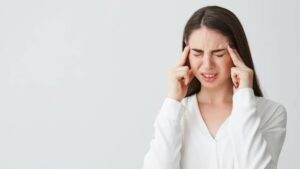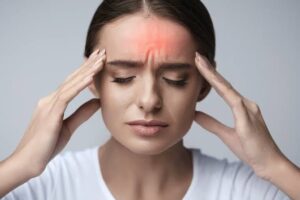- HEADACHE & FACIAL PAIN

Most common Neurological symptom but seldom associated with significant
Neurological Disease unless Other Signs Present .
Usually Patient is afraid of Serious Brain Disease but there is Mismatch between
feeling and actual Likelyhood.
COMMON CAUSES OF FACIAL PAIN :-
1.Tension Headache
2. Migraine
3. Cluster Headache
4. Raised Intra Cranial Pressure
5. Benign Paroxysmal Headache
6. Trigeminal Neuralgia
7. Atypical Facial Pain
8. Post Herpetic Neuralgia

Duramater, Dural Sinuses, Proximal Sinuses of Large Pial Blood Vessels are Sensitive to Pain. Pain sensitive intra Cranial Structures are innervated by Branches of Trigeminal Nerve & Upper Cervical Nerves. This Explains Patterns of
Pain Refferal.
DIAGNOSTIC APPROACH.
Headache with normal Newcological examination unlikely to have serious disorders so history is very important so ask for :-
1.Time of Onset
2.Time of Day on Onset of Maximal pain. 3.Effect of posture, coughing & Straining
4.Location of Pain
5. Any Associated Symptom
TEMPO OF ONSET
Can be divided into 2 Groups-
A Acute onset & B. Chronic (Wks)
A. Acute Onset Headaches-consider serious Neurological Disease-2 Important-
1. Sub Arachinoid Haemorrhage
2 Migraine Variant
B. Sub Acute Onset Headache (Within Hours) – Likely to be MM
Migraine
Meningitis
Look for Vomiting, Neck Stiffness, Fever or Focal Neurological Signs.
Intermittant Headaches over period of Days or Weeks are likely to be Migrainous.
TIME OF DAY :-is Important to further Differentiate
Raised IntraCranial Tension–are on Awakening & less on Standing .
Raised IntraCranial Headaches like Mass, Hydrcephallus, etc, Increase on Coughing, Sneezing or Forward Bending.
So, Headaches of RAISED INTRACRANIAL TENSION-
1.Worse in Morning. Improves through the Day
2.Associated with Morning weakness .
3.Worse on Bending Forward
4.Worse with Coughing & Straining
5.Releived by Analgesia
6.Dull Ache, Often Mild
TENSION TYPE HEADACHES:
Most common Type of Headache.
In some form experienced by majority of Population.
It is Constant Generalised and Radiates to Occipital region.
No Vomiting or Photophobia.
May Continue for weeks or months.
Less Noticeable when Patient is Occupied
Increases in Later Part of Day.
Local Tenderness may be Present.
Poor Response to Ordinary Analgesia.
Emotional Strain or Anxiety ia Common.
Dull, tight or like a Pressure .
MANAGEMENT:
1. Careful Assessment & Discussion
2. Re-assurance
3. Do not Use Excessive Analgesics, Particularly Codeine,-as it may worsen the Headache ANALGESIC HEADACHE
4. Physiotherapy with Muscle Relaxant
5. Stress Management
6. Low Dose Amitryptelene – 10 Mg (Antdepressant)
MIGRAINE HEADACH / EPISODIC PAROXYSMAL HEADACHE :-
CLINICAL FEATURES:
It is usually Episodic Paroxysmal Headache.
It is TRIAD of
1. Paroxysmal Headache
2. Nausea/Vomiting
3. Aura of Focal Neurological Events – usually Visual
but sometimes Aura may be Absent.
Life time Prevalence is 20% Females & 6 % Males
Classical Migraine Attack
*Starts with Non Specific Prodrome of Malaise & Irritability,
*Followed by Aura of Focal Neurological Events
This Includes :-
1. Visual- Shimmering Silvery Zigzag Lines
2. Tingling & Numbness
3. Aphasia
*Then Severe Throbbing Hemicranial Headache with Photophobia & Vomiting.
*Patient Prefers dark quiet room & sleep
ETIOLOGY
*Largely Unknown
*Family History is Often Positive
*Female Preponderance
*Contraceptive Pills exacerbates the pain.
*Dietary Constituents- Ceese, Chocolate, Red Wine.
*Usually after completion of Stressful Event i.e. when Pt starts Rest
MANAGEMENT
1.Avoidance of Precipitants or Exacerbating Factors
2. Simple Analgesics-
Combination of Paracetamol & NSAIDS + Anti Emetics.
3 Local Counter Irritants.
4. In Severe Attecks-5 HT Agonists( Triptans)- Vasoconstricts Ergot Preparations.
5. Prophylaxis:
Long Term
1. Propranolol-80 Mg/Day
2. Tricyclic Antidepressants
3. Sodium Valproate-300 Mg/Day
4. Flunarazine-10 Mg/Day
6. Stress Management
MIGRAINOUS NEURALGIA ( CLUSTER HEADACHE)
*Less common than Migraine
*Male Preponderance
*It is Periodic, Severe, Unilateral Periorbital.
*Pain is accompanied by Conjunctival Congestion & Lacrimation.
*It is breif (30-90 Mys) but severe.
Treatment: Injection of Sumatriptan & 100% Oxygen Inhalation
PROPHYLAXIS by Verapamil or Methysergide.
COITAL & EXERCISE INDUCED CEPALGIA:-
EVO
Sudden severe Headache at the Climax of Sexual Intercourse in Middle aged Man.
Usually for 10-15 Mts.
Treatment by Ordinary Analgesia
No Vomiting or Neck Stiffness
BENIGN PAROXYSMAL HEADACHES:
*These are very breit from few seconds to 1-2 Mts.
*These are like Stabbing, Bursting or Piercing type.
Due to Neuralgia, Migraine or Intreranial Pathology
TRIGEMINAL NEURALGIA:
*It causes very sharp Lancinating Pains
*It is in Second & Third Divisions of Trigeminal Nerve Territory.
*Usually Middle aged or Elderly Patients.
*Pain is severe & very breif but REPITITIVE.
*Precipitated by Touching Trigger Zones within Trigeminal Territory.
ETIOLOGY suggests-
Compression of Trgeminal Nerve Rootlets at their entry to Brain Stem.
MANAGEMENT:
1. Responds to Carbamazepine 300 Mg BD to maximum of 1200 Mg/Day
2. Phenytoin & Gabapantine
3. ALCOHOL or PHENOL Injection in branches of Nerve.
4. Percutaneous Radiofrequency Ablation near Gasserion Ganglion.